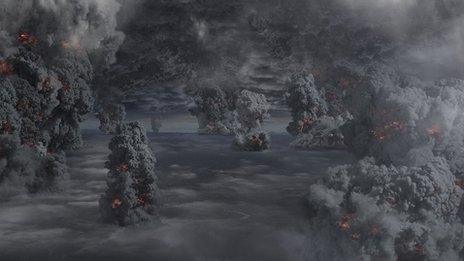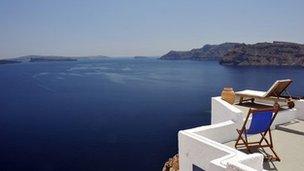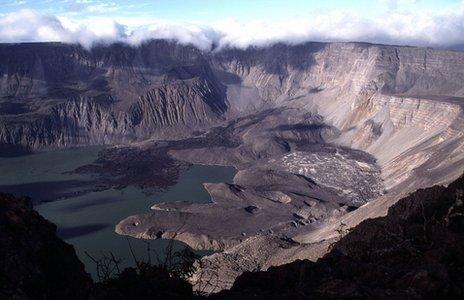Mega volcanoes 'may be predicted'
- Published

An artist's impression of multiple eruptions as a "super volcano" explodes. The new research suggests we may be able to predict such events decades earlier
The eruption of some of the largest volcanoes on the planet could be predicted several decades before the event, according to researchers.
Analysis of rock crystals from the Greek island of Santorini suggests eruptions are preceded by a fast build-up of magma underground, which might be detected using modern instrumentation.
Such volcanoes can produce enough ash and gas to temporarily change the global climate.
The research, external is in the journal Nature.
Volcanologists refer to history's largest volcanoes as "caldera-forming eruptions", as the magma ejected is so voluminous that it leaves a massive depression on the Earth's surface and a crater-like structure known as a caldera.
The largest of these volcanoes have been dubbed "supervolcanoes" and their eruptions can trigger devastation with global impacts.
Such volcanoes can lie dormant for hundreds of thousands of years before blowing. But while researchers believe seismic data and other readings would give us a few month's notice of such an eruption, the new study suggests we might anticipate these events much earlier.
"When volcanoes awaken and when the magma starts to ascend to the surface, cracking rock as it does, it sends out signals," Prof Tim Druitt of France's Blaise Pascal University and lead researcher told BBC News.
"You get seismic signals, you get deformation of the surface, increasing gas emission at the surface - and this can be detected.
"The question we're addressing here is what's going on at depth prior to these big eruptions. The classical view was that during long repose periods over thousands of years, magma slowly accumulates a few kilometres below the volcano and finally it blows.

The Greek island of Santorini is actually the remains of a massive volcanic eruption
"What we're finding is that there's an acceleration phase of magma build-up on a time scale of a few decades, and that's surprisingly short given the thousands of years of repose that have preceded that eruption."
The evidence comes from analysis of crystals in pumice rock from the Santorini site, which the researchers in France, Switzerland and Singapore analysed using modern instrumentation including electron and ion microprobes.
"The changes in composition of the crystals with time provide little histories of how the magma itself has evolved," said Prof Druitt.
"What we found was that all the crystals in the magma grew within a few decades of the eruption."
Early warning
Caldera-forming eruption sites can be found all over the world, although it is believed that all are currently dormant. They include sites in Yellowstone National Park in the United States, Campi Flegrei in Italy and Santorini and its accompanying islands.
The eruption at the latter site over 3,600 years ago is called the "Minoan" eruption as it occurred at the height of the Minoan civilisation on the nearby island of Crete and was once thought to have caused its collapse, although that is now a moot point.
Predicting such events years rather than months before they happen could prove vital, says Prof Druitt.
"What we're saying is that all caldera volcanoes, even those in remote regions of the globe, should be monitored using highly sensitive modern instruments in order to pick up these deep signals which may suggest reactivation," he said.
"If you had a big eruption of this sort, let's say in the middle of Europe today, the effects would be enormous and a few months might not be enough to get your act together."

A volcanic "caldera" like this one on the Galapagos Islands can change the global climate when they erupt
Commenting on the paper, Prof David Pyle, a volcanologist from Oxford University said: "This new work on Santorini sheds new light on what happens in the lead-up to the rare catastrophic eruptions, like the Bronze Age 'Minoan' eruption, which happen every 20,000 years or so.
"The new evidence from mineral grains appears to strengthen the idea, which has been developing in recent years, that large magma systems appear to awaken from long periods of repose only shortly (months, years or decades) prior to eruption.
"That is, the magma which eventually erupts appears to rise into position, in the top few kilometres of the crust, only a short time before the eruption begins."
However, he said the next problem was to try to understand what was causing this accelerated build up of magma.
"The challenge for volcanologists is to understand what it is that causes these bursts of melt movement; to understand where the melts have come from, and to be able to recognise their signals before an eruption begins."
- Published22 November 2011
- Published28 September 2010